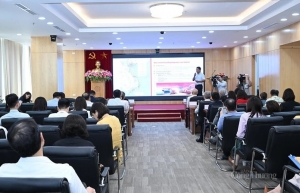Demystifying the process of digital transformation
While the term digital transformation is widely used, not all business leaders fully comprehend its meaning. Could you explain what it is when it comes to business?
Despite the ubiquity of the term, its precise definition eludes many business leaders. To simplify, let’s use the evolution of a wristwatch as an example, guiding you through four stages: manual operations, digitisation, digitalisation, and digital transformation.
 |
| Shashi J, partner of Consulting at EY Consulting Vietnam JSC |
In the 1970s and 1980s, businesses primarily operated manually, which represents the first stage. The computer revolution that took place soon afterwards led many businesses to transition to computerisation, marking the second stage as digitisation. The third stage, digitalisation, refers to the process of converting analogue data into a digital format, enabling the data to be processed by computers or other digital devices.
The fourth and most challenging stage is digital transformation. While some might argue that digitalisation and digital transformation are synonymous, at EY, we consider them distinct facets of business.
Today, my watch captures my thoughts, heartbeats, and a variety of other data. It even nudges me to stand up and walk if I’ve been sedentary for too long. But how does this apply to business? Businesses can leverage technology to monitor the pulse of their various functions, including finance, production, sales, and customers.
Technology becomes a tool for businesses to extract and analyse their data, yielding valuable insights. This information enables business owners to formulate actionable strategies, such as resource allocation, time optimisation, or exploring a different customer segment, to achieve their business goals.
Just like how a smartwatch will display useful information for you to take an action, smart or digital systems should be able to do the same but at an enterprise scale. Thus, we believe digital transformation is achieved when a business organisation can achieve an informed decision, take action on it and deliver tangible results in a timely manner leveraging on digital technologies and assets.
Several years ago, Forbes assessed the risk of failure in digital transformation to be 84 per cent. Could you sexplain what that means?
The assertion that 84 per cent of digital transformation journeys fail was indeed a bold one. You can evaluate this statement for yourself. How often organisations or businesses in Vietnam announce their intention to embark on a digital journey via social media?
The most common example of such an endeavour is the adoption of enterprise resource planning (ERP), one of the first significant steps businesses in Vietnam take to enhance their operations – specifically in areas of procurement, supply chain, HR, and manufacturing. How often do businesses announce successful ERP implementation and satisfaction with results? Not often.
The EY-Parthenon 2022 Digital Investment Index survey of C-level executives from large companies worldwide showed an increase in existing technology investments and the adoption of technologies such as chatbots, AI, machine learning, blockchain, and augmented reality.
Many companies have been building data platforms through investments in the cloud and the Internet of Things (IoT). The number of companies that reported realising the full benefits of investing in cloud, IoT, and AI increased by 54 per cent in 2022, compared with 2020. But even with the right strategic intent for digital transformation and a well-communicated vision, some companies, even large ones from around the world, stumble at various implementation phases of the journey.
Recognising these challenges helps us to provide the necessary support for clients to navigate these common pitfalls. EY has a proven track record of delivering digital engagements on time, within budget and scope. Our prestigious awards and client testimonials demonstrate our commitment to helping clients thrive in their digital transformation efforts.
We believe that a successful digital transformation requires an innovative culture and a clear vision from the top, which can then be translated into an actionable business strategy. Digital transformation is and should be a part of the company’s DNA. Instead of having digital as an add-on, successful companies infuse digital capabilities throughout the business and consider it as a journey, not a project.
How would you advise a business organisation to successfully carry out a digital transformation journey?
Successful digital transformation hinges on four key ingredients: technology, operations, business, and people. When organisations embark on the journey towards digital transformation, whether it’s through formulating a strategy or implementing some projects, the focus is heavily placed on technology. Perhaps it’s the term “digital” that naturally leads one to associate it with technology, where software vendors are more than willing to cater to your needs. Buying software could be as simple as buying a car.
Venturing from technology into the slightly trickier aspect of operations, which drives growth as well as optimise the operational efficiency through intelligent automation and process re-design. This brings us to an area where EY teams excel as independent consultants.
The third ingredient is business - a fully integrated business strategy that shows where digital enables and provides services for a better customer journey.
However, the bedrock of digital transformation would be people. Human emotions, aspirations, insecurities, and relationships introduce layers of complexity to the transformation process. For example, an employee who has been with the company for 20 years may experience various emotions upon hearing about changes in systems and processes. Fear of becoming obsolete or feeling less important are common reactions. Garnering their support for the digital transformation becomes a colossal challenge.
We utilise a top-tier change-management strategy to navigate this emotional landscape. Importantly, this methodology is adaptable to specific cultural and regional differences. Our success lies in transitioning employees from their current state to their desired mindset, taking into account individual corporate cultures and working styles.
Stereotypically, companies view digital transformation as installing advanced software, developing a mobile app, or enhancing their website. However, the transformation journey is more akin to a caterpillar changing into a butterfly rather than merely changing their colours.
Success in digital transformation requires a masterful blend of ingredients, much like baking the perfect cake. At EY, our role is to help clients achieve the best possible outcome, with innovative and forward-thinking strategies.
You mentioned that humans are game-changers and there’s resistance at some level or department which might be replaced by technologies. How would you recommend dealing with this issue?
A Transformation Leadership study conducted by EY teams and the University of Oxford’s Saïd Business School in 2021 found that the complex factors influencing a transformation’s success or failure are rooted in human emotional behaviour. Therefore, the study suggested that organisations need to cultivate a culture of change and understand the interdependencies associated with the emotional behaviour of the overall workforce and key senior stakeholders.
I concur with these solutions. Based on my consulting experience, seamless digital transformations revolve around two critical points: mitigating shocks and addressing skill deficiencies. For instance, if we were to replace a core system in a year-long project, it is crucial to communicate this planned change to employees right from the outset.
This approach eases uncertainty and allows employees time to understand the why behind the change. Gradually, we assist employees in transitioning from the existing way of working to the new system. By effectively managing these changes, we avoid chaos and foster success.
Another aspect of equal significance is addressing skill gaps. Organisations undertaking digital transformations need to have the appropriate skill sets. Moreover, a proactive plan to enhance the workforce’s capabilities is vital to withstand ongoing and future digital transformations.
*The views reflected in this article are those of the interviewee and do not necessarily reflect the views of the global EY organisation or its member firms.
 | Businesses take heed of the dual transition Combining digital transformation with the green transition has become a more urgent requirement for enterprises to ensure business goals as well as social responsibility. |
 | Low-code: a powerful enabler for the digital transformation The low-code development platform is emerging as a powerful enabler for digital transformation. Nguyen Ngoc Hoang, director and digital innovation lead at KPMG in Vietnam, explains how it empowers business users to quickly create and adapt applications without the need for specialised programming knowledge and experience. |
 | Experts urge promotion of digital transformation in logistics, e-commerce Applying technology in logistics and e-commerce will bring many benefits, thus optimising the efficiency of these two sectors, and contributing to reducing logistics costs for the entire economy, heard a workshop in Hanoi on May 16. |
 | Groundwork laid for the dual transition Vietnam’s strategic focus on attracting high-quality foreign investment is being demonstrated through its emphasis on green and digital transformation projects, supported by robust legal frameworks and a strong commitment to sustainability and technological innovation. |
What the stars mean:
★ Poor ★ ★ Promising ★★★ Good ★★★★ Very good ★★★★★ Exceptional
Related Contents
Latest News
More News
- Positive projections for M&A interest from Thailand (December 03, 2025 | 09:40)
- Manifesting the first line of defence in cybersecurity (December 03, 2025 | 09:00)
- The transformational role AI can play in accounting arena (December 03, 2025 | 08:00)
- Unlocking 5G-AI potential in Singapore (December 03, 2025 | 08:00)
- Data-driven strategies vital for a fast-evolving nation (December 02, 2025 | 09:41)
- Policy to practice: how Vietnam can lead the region (November 26, 2025 | 16:03)
- Mobilising private capital at scale vital for climate battle (November 26, 2025 | 15:36)
- VILAF and Yoon & Yang launch Vietnam - Korea Practice Unit (November 26, 2025 | 15:16)
- Trademark disputes challenge foreign firms in Vietnam (November 24, 2025 | 15:30)
- Rich IPO pipeline can catalyse strategic dealmaking (November 17, 2025 | 11:36)

 Tag:
Tag:

















 Mobile Version
Mobile Version